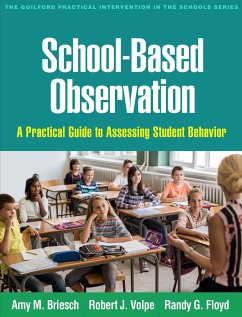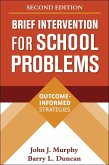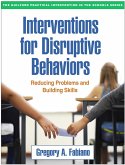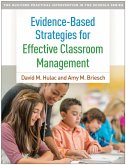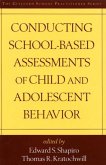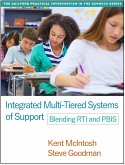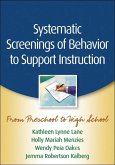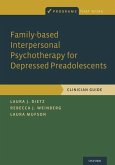Amy M Briesch, Robert J Volpe, Randy G Floyd
School-Based Observation
A Practical Guide to Assessing Student Behavior
Amy M Briesch, Robert J Volpe, Randy G Floyd
School-Based Observation
A Practical Guide to Assessing Student Behavior
- Broschiertes Buch
- Merkliste
- Auf die Merkliste
- Bewerten Bewerten
- Teilen
- Produkt teilen
- Produkterinnerung
- Produkterinnerung
Widely used to assess social-emotional and behavioral referral concerns in grades PreK-12, systematic direct observation is an essential skill for school psychologists and other educators. This accessible book helps practitioners conduct reliable, accurate observations using the best available tools. Chapters present effective coding systems for assessing student classroom behavior, the classroom environment, behavior in non-classroom settings, and behavior in a functional assessment context; also provided are guidelines for developing new codes when an appropriate one does not already exist.
Andere Kunden interessierten sich auch für
![Brief Intervention for School Problems Brief Intervention for School Problems]() John J MurphyBrief Intervention for School Problems32,99 €
John J MurphyBrief Intervention for School Problems32,99 €![Interventions for Disruptive Behaviors Interventions for Disruptive Behaviors]() Gregory A FabianoInterventions for Disruptive Behaviors39,99 €
Gregory A FabianoInterventions for Disruptive Behaviors39,99 €![Evidence-Based Strategies for Effective Classroom Management Evidence-Based Strategies for Effective Classroom Management]() David M HulacEvidence-Based Strategies for Effective Classroom Management38,99 €
David M HulacEvidence-Based Strategies for Effective Classroom Management38,99 €![Conducting School-Based Assessments of Child and Adolescent Behavior Conducting School-Based Assessments of Child and Adolescent Behavior]() Thomas R. Kratochwill / Edward S. Shapiro (eds.)Conducting School-Based Assessments of Child and Adolescent Behavior45,99 €
Thomas R. Kratochwill / Edward S. Shapiro (eds.)Conducting School-Based Assessments of Child and Adolescent Behavior45,99 €![Integrated Multi-Tiered Systems of Support Integrated Multi-Tiered Systems of Support]() Kent McIntoshIntegrated Multi-Tiered Systems of Support51,99 €
Kent McIntoshIntegrated Multi-Tiered Systems of Support51,99 €![Systematic Screenings of Behavior to Support Instruction Systematic Screenings of Behavior to Support Instruction]() Kathleen Lynne LaneSystematic Screenings of Behavior to Support Instruction44,99 €
Kathleen Lynne LaneSystematic Screenings of Behavior to Support Instruction44,99 €![Family-Based Interpersonal Psychotherapy for Depressed Preadolescents Family-Based Interpersonal Psychotherapy for Depressed Preadolescents]() Laura J. DietzFamily-Based Interpersonal Psychotherapy for Depressed Preadolescents73,99 €
Laura J. DietzFamily-Based Interpersonal Psychotherapy for Depressed Preadolescents73,99 €-
-
-
Widely used to assess social-emotional and behavioral referral concerns in grades PreK-12, systematic direct observation is an essential skill for school psychologists and other educators. This accessible book helps practitioners conduct reliable, accurate observations using the best available tools. Chapters present effective coding systems for assessing student classroom behavior, the classroom environment, behavior in non-classroom settings, and behavior in a functional assessment context; also provided are guidelines for developing new codes when an appropriate one does not already exist.
Produktdetails
- Produktdetails
- Verlag: Guilford Publications
- Seitenzahl: 270
- Erscheinungstermin: 16. Februar 2018
- Englisch
- Abmessung: 264mm x 201mm x 18mm
- Gewicht: 567g
- ISBN-13: 9781462533480
- ISBN-10: 1462533485
- Artikelnr.: 48700945
- Herstellerkennzeichnung
- Libri GmbH
- Europaallee 1
- 36244 Bad Hersfeld
- gpsr@libri.de
- Verlag: Guilford Publications
- Seitenzahl: 270
- Erscheinungstermin: 16. Februar 2018
- Englisch
- Abmessung: 264mm x 201mm x 18mm
- Gewicht: 567g
- ISBN-13: 9781462533480
- ISBN-10: 1462533485
- Artikelnr.: 48700945
- Herstellerkennzeichnung
- Libri GmbH
- Europaallee 1
- 36244 Bad Hersfeld
- gpsr@libri.de
Amy M. Briesch, PhD, is Associate Professor in the Department of Applied Psychology at Northeastern University. Her primary research interests include the role of student involvement in intervention design and implementation, and the development of feasible and psychometrically sound measures for the assessment of student behavior in multi-tiered systems of support. She was a recipient of the Lightner Witmer Award for early-career scholarship in school psychology from Division 16 (School Psychology) of the American Psychological Association, and is an Associate Editor of the Journal of School Psychology and an elected member of the Society for the Study of School Psychology. Dr. Briesch has authored over 50 publications, including the books Direct Behavior Rating: Linking Assessment, Communication, and Intervention; Evidence-Based Strategies for Effective Classroom Management; and School-Based Observation: A Practical Guide to Assessing Student Behavior. Robert J. Volpe, PhD, is Professor in the Department of Applied Psychology at Northeastern University and Co-Director of the Center for Research in School-based Prevention. His research focuses on behavioral assessment in school-based problem-solving models, and evaluating classroom interventions for students with emotional and behavior problems. Dr. Volpe is former President of the Society for the Study of School Psychology and serves on the advisory board of Journal of School Psychology and on the editorial boards of School Psychology Review and Journal of Attention Disorders. He has authored or coauthored over 130 journal articles, books, and book chapters. His books include Daily Behavior Report Cards: An Evidence-Based System of Assessment and Intervention, Effective Math Interventions: A Guide to Improving Whole-Number Knowledge, and School-Based Observation: A Practical Guide to Assessing Student Behavior. Randy G. Floyd, PhD, is Professor and Chair in the Department of Psychology at the University of Memphis. His research focuses on understanding the measurement properties of psychological assessment techniques and reducing error in measurement. He is a past editor of the Journal of School Psychology and currently serves on the editorial boards of the Journal of Psychoeducational Assessment, the Journal of School Psychology, School Psychology International, and School Psychology Review. Dr. Floyd is a Fellow of the American Psychological Association Division 16 (School Psychology) and an elected member of the Society for the Study of School Psychology. He has authored or coauthored more than 80 publications, including Assessing Intelligence in Children and Adolescents: A Practical Guide and School-Based Observation: A Practical Guide to Assessing Student Behavior.
I. Key Concepts of Direct Observation
1. The Role of Direct Observation in School-Based Settings
2. Foundations of Direct Observation
3. Obtaining Trustworthy Results from Observation: The Basic Principles of
Psychological Measurement
4. Improving Data Quality: Suggested Guidelines for Training Observers and
Conducting Observations
II. Use of Specific Observation Codes
5. Conducting Observations in Classroom Settings
6. Observing the Classroom Environment
7. Extending Observations to Non-Classroom Settings
8. Using Observation to Support Functional Assessment
9. Thinking Outside of the Box: Creating a Novel or Hybrid Coding Scheme
III. Using Assessment Data to Inform Decision Making and Intervention
10. Interpreting and Sharing Observation Results
Appendix A. Measurement Standards Used in Evaluating Systematic Observation
Codes
Appendix B. Glossary of Operational Definition
Appendix C. Reproducible Coding Forms
1. The Role of Direct Observation in School-Based Settings
2. Foundations of Direct Observation
3. Obtaining Trustworthy Results from Observation: The Basic Principles of
Psychological Measurement
4. Improving Data Quality: Suggested Guidelines for Training Observers and
Conducting Observations
II. Use of Specific Observation Codes
5. Conducting Observations in Classroom Settings
6. Observing the Classroom Environment
7. Extending Observations to Non-Classroom Settings
8. Using Observation to Support Functional Assessment
9. Thinking Outside of the Box: Creating a Novel or Hybrid Coding Scheme
III. Using Assessment Data to Inform Decision Making and Intervention
10. Interpreting and Sharing Observation Results
Appendix A. Measurement Standards Used in Evaluating Systematic Observation
Codes
Appendix B. Glossary of Operational Definition
Appendix C. Reproducible Coding Forms
I. Key Concepts of Direct Observation
1. The Role of Direct Observation in School-Based Settings
2. Foundations of Direct Observation
3. Obtaining Trustworthy Results from Observation: The Basic Principles of
Psychological Measurement
4. Improving Data Quality: Suggested Guidelines for Training Observers and
Conducting Observations
II. Use of Specific Observation Codes
5. Conducting Observations in Classroom Settings
6. Observing the Classroom Environment
7. Extending Observations to Non-Classroom Settings
8. Using Observation to Support Functional Assessment
9. Thinking Outside of the Box: Creating a Novel or Hybrid Coding Scheme
III. Using Assessment Data to Inform Decision Making and Intervention
10. Interpreting and Sharing Observation Results
Appendix A. Measurement Standards Used in Evaluating Systematic Observation
Codes
Appendix B. Glossary of Operational Definition
Appendix C. Reproducible Coding Forms
1. The Role of Direct Observation in School-Based Settings
2. Foundations of Direct Observation
3. Obtaining Trustworthy Results from Observation: The Basic Principles of
Psychological Measurement
4. Improving Data Quality: Suggested Guidelines for Training Observers and
Conducting Observations
II. Use of Specific Observation Codes
5. Conducting Observations in Classroom Settings
6. Observing the Classroom Environment
7. Extending Observations to Non-Classroom Settings
8. Using Observation to Support Functional Assessment
9. Thinking Outside of the Box: Creating a Novel or Hybrid Coding Scheme
III. Using Assessment Data to Inform Decision Making and Intervention
10. Interpreting and Sharing Observation Results
Appendix A. Measurement Standards Used in Evaluating Systematic Observation
Codes
Appendix B. Glossary of Operational Definition
Appendix C. Reproducible Coding Forms

